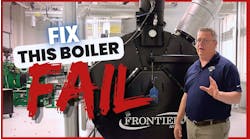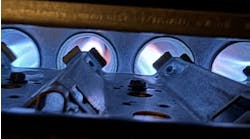Latest from Hydronics
Sponsored
This Broomell Receiver was my inspiration for learning as much as I could about steam heating. Someone early in my career dropped it off at the loading dock. I wish I could remember who, so I could give them credit, but you know by now that I don’t remember some things at all.
What I do remember is wondering what the heck this thing was, with a gauge glass that isn’t connected at the top and a chain dangling from the side. I had an idea that the chain would be connected to the draft doors of a coal fired boiler because I had seen that somewhere before.
What I had never seen before was a gauge glass on a steam system that didn’t have a valve on both the top and the bottom. You can clearly see in the photo that the gauge glass only has the wood wheel valve on the bottom. The broken wood wheel just happened after 30 plus years (adds character as they say).
Detective Work
Immediately after seeing this steam artifact for the first time, I went to a set of file cabinets in the first floor warehouse that we called the “Archives.” Inside those drawers is a collection of early literature from various boiler and radiator manufacturers, dating back to the very early 1900s. It’s one of my favorite places.
I spent a lot of time researching boiler sizes from cryptic boiler model numbers that were relayed to me from contractors in these files. Sometimes it helped them in the replacement boiler sizing process. But they also held literature from manufacturers that made steam specialties, like Broomell.
Sure enough, I found quite a few items, from a sales inspired comparison of Vapor Steam heating systems to Hot Water heating systems to a 40 page book of photos of successful installations across the United States, some of buildings in Cincinnati. I was amazed and inspired.
What you see in the photo controlled the steam pressure in the system. It was invented and patented by Albert P. Broomell, of York PA in 1902. This wasn’t his first patent and it wasn’t his last. His 24 patents ranged from improvements to globe valves to improvements to the spark plugs for automobile engines.
Besides designing and manufacturing the Vapor Heat system of steam heating, he designed and built an automobile, originally the six-wheel Pullman Motor Car. Eventually it became a more conventional four-wheel automobile. None of the information about him was in the archives. I found it on the internet for your interest and mine. Part of my job here is to keep you entertained.
Vapor Heat
Broomell didn’t make the boilers or the radiators, just the specialties that made them work as a Vapor Heat system. His systems were different because his operated at the very low pressure of 8 ounces. He called it Vapor Heat. This is at a time when most steam heating systems operated at much higher pressures. His sales literature showed vapor gently wafting out of a tea kettle.
While the receiver kept the pressure low, the Broomell radiator valves, piped to the top of the radiator, were adjustable to five different settings. He or his advertising department called them quintuple adjustable. The settings corresponded to the size of the radiator, effectively limiting the amount of steam able to enter the radiator to the size of the radiator. In theory, they only let in enough steam so that all the steam condenses before it leaves the radiator.
Since it was a two pipe system, the air and condensate pass from the radiator at the bottom. He made a device for that also. It has no moving parts and looks something like a typical union elbow used on hot water systems. But it had a little belly on the bottom to fill with condensate to trap any steam in the radiator and a little hole at the top to allow the air to pass to the dry return.
In his system, the dry return didn’t have an air vent. The condensate found its way downhill to the receiver while the air passed to a “condensing radiator” that was hung from the ceiling. The air would pass through it, to make completely sure there wasn’t any steam left, before it passed through a pipe that was terminated in the boiler’s chimney. I found this particularly interesting, since I hadn’t seen that before.
The draft in the chimney would pull a slight vacuum on the return side to help get the air out of the piping and radiators, allowing the steam to move evenly and quickly to the radiators. This was an innovation that wasn’t used by many manufacturers. Not all innovations stand the test of time or the rigors of actual use, but the concept seems very effective.
Innovative Technology
The cars Broomell built were marketed to the wealthy, rather than to the masses like a Ford. In today’s numbers, the list price would be $82,000. Maybe he priced his Vapor Heat system out of the heating business.
The valves and return elbows are compatible with automatic fired boilers, but the receiver cannot be integrated into a modern system. The receiver controlled the pressure by opening and closing the draft doors on a coal fired boiler connected by the chain. As the pressure rose up to 8 ounces, the draft doors would close to decrease the firing rate. It was truly a modulating steam boiler, without the inducer fan assembly in today’s mod-con boilers.
It also has a built-in relief valve that dangerously discharges steam straight into the atmosphere, not into a pipe that safely directs it to the floor. If you look closely at the photo, the component that replaced it in an automatic fired system is sitting on the bottom shelf of the display case to the left. A company still in the business, but now with a different name, made the pressure control called the Vaporstat, which operates in ounces of pressure like the Broomell receiver.
Patrick Linhardt is a forty-year veteran of the wholesale side of the hydronic industry who has been designing and troubleshooting steam and hot water heating systems, pumps and controls on an almost daily basis. An educator and author, he is currently Hydronic Manager at the Corken Steel Products Co.
Patrick Linhardt
Patrick Linhardt is a forty-one-year veteran of the wholesale side of the hydronic industry who has been designing and troubleshooting steam and hot water heating systems, pumps and controls on an almost daily basis. An educator and author, he is currently Hydronic Manager at the Corken Steel Products Co.


